1. Meet the Pioneer BDR-206MBK BDXL Burner

The Pioneer BD-R206M series of Blu-ray disc drive's are the industry first than can write up to 128 Gbytes on a single BDXL Quad Layer disc (equal to 27 single layer DVDs). Designed for professional users, this computer drive allows users to author high-definition Blu-ray Disc content while also delivering the ability for high-capacity data storage. The drive can read BD-ROM discs, read/write triple/dual/single layer BD-R and BD-RE discs, read DVD-ROM, and read/write most DVD and CD recordable media formats.
Compared to the single and dual layer Blu-ray disc formats, the BDXL still uses the Partial
Response - Maximum Likelihood (PRML) data recover methods and 17PP channel modulation. However, BDXL features an increased linear density. Therefore Limit equalizer jitter on BDXL is no longer measurable. Instead, the
i-MLSE (Maximum Likelihood
Sequence Error estimation) method is used for the disc evaluation.
In other words, while the SL and DL Blu-ray formats can achieve a good enough error rate without applying a ML
technique like Viterbi decoding,
the BDXL format requires the use of an ML technique in order to have a sufficient error rate. In addition, the thickness of the BDXL discs' spacer (layer) is different than BD SL and DL to avoid any optical
interference issues introduced by the disc's multi-layers. For both TL and QL, the BDA has specified 2X
and 4X recording of 72~144Mbps user transfer rate.More information on the BD XL format is provided in the following pages.
The Pioneer BD-R206M writer also provides a maximum write speed of 6X with BD-R SL media (25GB). It is able to burn and read 3-layer and 4-layer BD-R XL (100GB and 128GB) and 3-layer BD-RE XL (100GB) discs at 2X/4X and and 2X speeds, respectively. By the time we write this article, only BD-R TL (100GB) are available at the market, so we will test the drive using this disc.
The drive is compatible with the Blu-ray 3D format and of course is also capable of writing on BD-R's (6X), BD-R DL (6X), BD-R LtH (6X), BD-RE SL /DL at 2x, DVD recordables (SL / DL) at 8X max, DVD-RW at 6X, DVD+RW at 8X, DVD-RAM at 5X and CD-R/RW at 24X.
Key technologies engineered into the BDR-206MBK include:
- Limit Equalizer technology: the technology purifies unclear signals generated when reading data on BD discs and improves reading quality.
- Disc vibration Resonance Stabilizer dedicated for precision writing in a high speed environment: high speed disc rotation causes disc warping due to disc resonant vibration. This results in unstable writing quality, especially in the outer areas the newly designed top chassis, air flow caused by the high speed rotation will press the disc.

- Airtight design: the writer's airtight sealed housing prevents dust ingress to stop impurities impacting read/write quality. It also significantly reduces operating nose to enhance applications such as listening to music or watching movies

 - PowerRead: the PowerRead function ensures that discs in a bad condition (e.g with light scratches, and fingerprints and stains) can be play backed. The feature has been designed to enable smooth playback of BD and DVD video discs and it requires a compatible software.
- PowerRead: the PowerRead function ensures that discs in a bad condition (e.g with light scratches, and fingerprints and stains) can be play backed. The feature has been designed to enable smooth playback of BD and DVD video discs and it requires a compatible software.
There is a difference between how AV and PC handle discs that are difficult to read. In a standard PC environment, DVD-Video is treated as 1 type of data; therefore, if a section is deemed unreadable, playback will stop. With PowerRead, the user-experience is similar to the AV side, making it possible to play the remainder of the disc. Note that with PowerRead, unreadable DVD or Blu-ray disc contents remain unreadable. PowerRead skips to the next readable address. PowerRead can be used for BD/DVD media that have been recorded in the BDMV/BDAV and DVD video/VR formats.
- PureRead: In addition, the drive features the "PURE READ " function, to compensate the digital noise introduced when a scratched or dusty audio CD is reproduced. The idea behind PURE READ is to try and correct damaged sectors, which are read from the Audio-CD. The feature re-reads damaged sectors to see if it can recover them. When these damaged sectors are read in a normal scenario, the sector may well be read without any serious error, but sometimes pops or crackles can be heard in the final ripped file. When a sector that is difficult to read is detected, the laser tries to re-read the damaged sector. Not just re-reading the sector, but the drive will actually adjust its read parameters (I.E. higher or lower laser power and the angle of the laser beam are adjusted) to try and get the best possible read-back from that damaged sector. An algorithm calculates the "best" or "average" result it achieves, and that information (I.E. the best-possible result) is then used as part of the final file. The Pure Read function is supported by (B's Recorder GOLD9, Windows Media Player 9 and Windows Media Player 9 software players.

The BDR-206MBK is currently sold in Europe to Pioneer's OEMs and direct to consumers from Pioneer distributors . U.S. consumers have the chance to get the BDR-206MBK now for a suggested retail price of $199. The U.S. bundle includes CyberLink's BD software which allows users to write to BDXL media plus author and playback BD and DVD movies as well.
Below you see the drive's specifications:
| Discs compatible for burning |
BD |
BD-R (Single / Dual / Triple (BD-R SL/DL/TL)/ Quadruple layer (BD-R QL))
BD-RE (Single / Dual / Triple layer (BD-RE SL/DL/TL) |
| DVD |
DVD-R , DVD-R DL, DVD-RW, DVD + R, DVD + R DL, DVD + RW
DVD+RW, DVD-RAM |
| CD |
CD-R, CD-RW, HS CD-RW, US CD-RW, US + CD-RW |
| Discs compatible for playing |
BD |
BD-ROM (Single / Dual layer), BD-R (Single / Dual / Triple / Quadruple layer), BD-RE (Single / Dual / Triple layer) |
| DVD |
DVD-ROM (Single / Dual layer), DVD-Video, DVD-R, DVD-R DL, DVD-RW
DVD+R, DVD+R DL, DVD + RW, DVD-RAM |
| CD |
CD-ROM (Mode 1 & 2), CD-ROM XA, Photo CD (Single / Multi-session)
Video CD, CD-DA, CD-Extra, CD-R, CD-RW |
| Interface |
Serial ATA Revision 2.6 |
| Write speeds |
BD |
-R |
6x Z-CLV, 4x CLV, 2x CLV |
| -R DL |
| -R Triple layer (TL) |
4x CLV, 2x CLV |
| -R Quad Layer (QL) |
| -R (LtH) |
6x Z-CLV, 4x CLV, 2x CLV |
| -RE |
2x CLV |
| -RE DL |
| -RE TL |
| DVD |
-R |
8x Z-CLV, 6x Z-CLV, 4x CLV, 2x CLV, 1x CLV |
| -R DL |
8x Z-CLV, 6x Z-CLV, 4x CLV, 2x CLV |
| -RW |
6x Z-CLV, 4x CLV, 2x CLV |
| +R |
8x Z-CLV, 6x Z-CLV, 4x CLV, 2.4x CLV |
| +R DL |
| +RW |
| -RAM |
5x CLV, 3x CLV, 2x CLV |
| CD |
-R |
24x Z-CLV, 16x CLV, 10x CLV, 4x CLV |
| -RW |
24x CLV, 16x CLV, 10x CLV, 4x CLV |
| Read Speed |
BD-ROM (single/dual) |
6X-CAV Max |
| BD-RE (Single) |
6x CAV Max |
| BD-RE (Dual) |
6X CLV Max |
| BD-R (Single, Dual) |
| BD-R (TL, QL ) |
4X CLV Max |
| BD-R LTH |
6X CAV |
| DVD-ROM (Single, Dual), DVD-R/+R, DVD-R DL / DVD+R DL, DVD-RW/ DVD+RW |
8X CAV Max |
| DVD-RAM |
5X Z-CLV Max |
| CD-ROM/CD-R/-RW |
24x CAV Max |
| Random Seek Time |
BD |
140ms |
| DVD |
| CD |
| Average Seek Time |
BD |
180ms |
| DVD |
| CD |
| Buffer size |
4MB |
| Installation position |
Horizontal / Vertical |
Suggested Working
Environment |
Supported OS: Microsoft Windows 7,Microsoft Windows Vista, Windows XP Home Edition / Professional
CPU: Intel Core Duo T2700, Intel Core 2 Duo E6300 or greater
Memory: 1GB ABOVE
HDD space: 50 GB or above |
| Dimensions and weight |
148 mm x 42.3 mm x 180 mm (W x H x D) 750 g |
Our test unit came to our labs without any software or special commercial packaging. However, the drive comes complete in the U.S. and Japan bundled with software for disc burning and authoring. The U.S. retail package includes Cyberlink's BD software which allows users to write to BDXL media plus author and playback BD and DVD movies as well. For a limited time the BDR-206MBK also comes with a piece of TDK BD-R TL (100GB) disc, free of charge. That's a great offer since the TDK disc - the only BDXL disc currently available at the market (Panasonic, Sharp and Sony also offer TDK OEM discs and Verbatim plans to release their discs in autumn) retail for $50~$60 !
Below you see the front panel of the drive:
 .
.
The rear panel is typical and has a power and SATA interfaces.
A new LSI has been designed in order to decode the increased data of the BD XL discs. By decreasing the size of the recorded pit on the disc's recording layer, the layer is capable of holding 33GB of data.
The new LSI is based on the Renesas R8J32730FP44 chip:

The drive uses Pioneer's high-performance pick-up unit that supports the BDXL format:
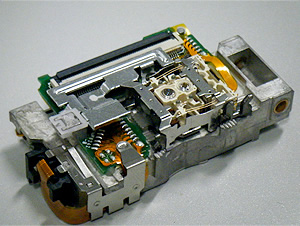
 The new pick-up unit is composed of the Movable Lens, the Liquid Component and the Movable Collimator Lens. The pick up is sensitive to adjust the right and precise position when focusing on the track of the media, especially when it deals with unbalanced media, or Tilt/thickness media.
The new pick-up unit is composed of the Movable Lens, the Liquid Component and the Movable Collimator Lens. The pick up is sensitive to adjust the right and precise position when focusing on the track of the media, especially when it deals with unbalanced media, or Tilt/thickness media.
The new lens control technology is able to correct the distorted signal caused from lens' rotation direction and radius direction.
The Liquid Component is able to correct the distorted signal caused by optical system. It is also helpful to correct the bad signal caused by a twisted disc.
The Movable Collimator lens can correct the bad signal caused by unbalanced disc.
Here is some extra information about the SATA drive:

2. CD, DVD and BD reading tests
For our CD/DVD/BD and Blu-ray transfer rate tests we used the OptiDrive Control v1.51 utility and a set of data and audio CD-R/RW/ROM, DVD-R/+R/-RW+RW/ROM as well as BD-R and BD-RE media. Here we test the maximum reading speed of the Pioneer drive for each type of disc.
We remind you that the Pioneer BDR-216 MBK drive supports the following maximum reading speeds: 24x for CDs, 8x for DVD and 6x for Blu-ray.
CD reading
- CD-ROM

- US RW

- AudioCD
Digital Audio Extraction or DAE is important when we try to read the files stored on an audio CD and store them in our hard disk drive. The procedure is not always that simple and the fidelity of the extracted data depend on the way each drive handles these data.
The majority of the software that support this procedure, commonly known as "ripping", will just read the audio files and store them on your hard disk. However, this approach is not recommended for all drives, since it may result to read or sync errors if your drive does not support report of C2 error pointer information and also what the author of the EAC (Exact Audio Copy) software describes as "accurate stream" and " non-caching."
According to EAC, the Pioneer BDR-206MBK drive supports "caching ", "Accurate stream" and does not report "C2 error pointer information.
Accurate stream and C2 error reporting is always welcome and contribute to reliable and fast audio extraction. Generally, if you select a drive for extraction better have a look that the drive does not cache audio data.

With these settings applied to EAC software, we perform a DAE of an audio CD to our HDD. Notice that the specific test will result in a slower DAE speed than what you would get if you simply select to rip the contents of the disc with another application. That's because EAC used its "Secure" ripping mode after we applied the drive's features (Caching, accurate stream , c2 error info) to the software, in order to have a reliable ripping with the specific drive. Since caching need to be defeated, the secure mode will be slow. When no read errors occur, it will usually something around a third to a fourth of the drive's maximum ripping speed(in case we had selected the default burst mode). The Pioneer drive ripped the audio tracks of the disc at an average ripping speed of 4.2x:
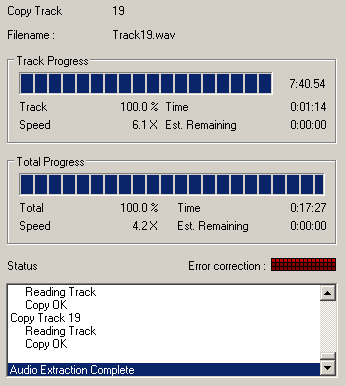
The advanced DAE test found in Nero Disc Speed utility is illustrated below. The drive finished the test at an average speed of 16.80x. No data or sync errors occurred:

Here is a transfer rate test with an Audio CD. The disc was read at 17.56x:

- 90/99 mins Audio disc

90min disc
The drive tried to read the specific disc using at 24x CAV, as it does with 700MB CD-Rs. However, soon it found it difficult to read the data of the 90min disc and slowed down to 4x, without however avoiding the read errors. The reading task finished at 4x CLV and the Opti Drive Control software returned an error during the "full stroke" access time test.

99min disc
The drive managed to read a 99 min data disc but still the Opti Drive Control software returned errors during the access time tests.
DVD reading
Now let's take a look at how the drive performs with DVD media. This time, a set of SL and DL DVD media was used. The drive is capable of reading at 8x maximum speed for DVD ROM SL and DL.
DVD-ROM SL
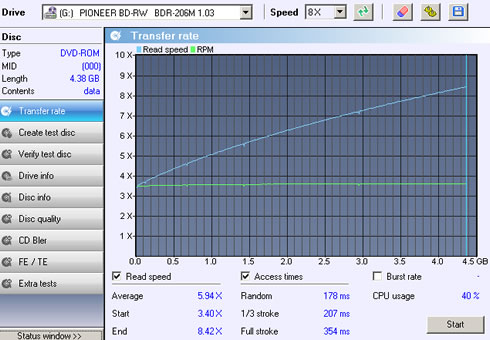
PTP DVD-ROM
The two layers of a PTP DVD-ROM disc are read sequentially with the drive starting reading from the inner part of the disc, which is the beginning of each layer, progressing towards its outer range.

OTP DVD-ROM
The first layer of an OTP dual layer DVD-ROM is read exactly the same way as the first layer of the PTP disc we tested previously. The difference here is the reading strategy of the second layer of the disc. The beginning of the second layer is located in the outer part of the disc, so the drive starts reading from the outer tracks and progresses towards the inner part of the disc.

DVD-R

DVD-RW
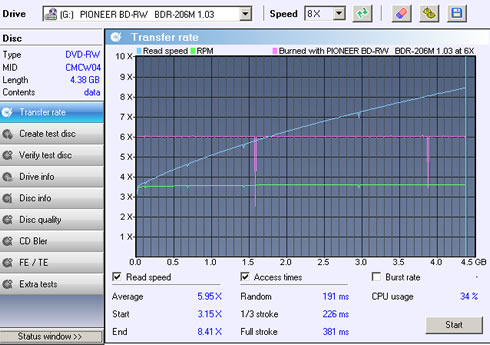
DVD+R

DVD+RW

DVD+R DL

DVD-R DL
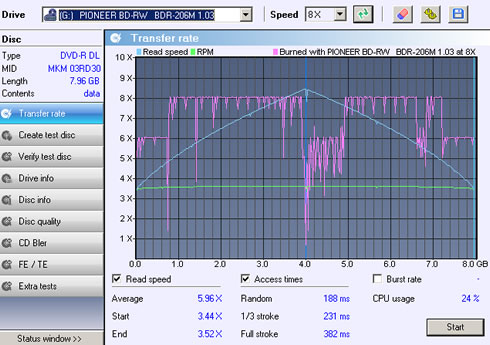
DVD-RAM 5x

DVD Ripping speed
Ripping of a single layer DVD movie:

- Blu-ray reading
Continuing, let's see how the drive reads the various Blu-ray recordable and ROM discs.
BD-ROM SL

BD-ROM DL
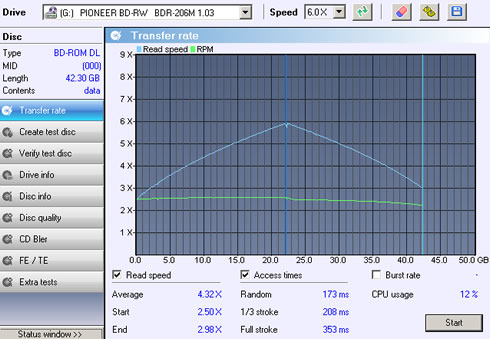
BD-R SL

BD-R SL LTH

BD-R DL

BD-RE SL

BD-RE DL

8cm BD-R SL (7.5GB)

8cm BD-RE SL (7.5GB)

Summary
Reading of almost all the discs was completed without read errors. The Pioneer is not the fastest reader around but it will read your discs at speeds matching its specifications.
3. Reading of defected CDs
This series of tests checks the drive's ability to correct/conceal possible erroneous data after reading artificially scratched / defective audio discs.
Using a CD-R in best shape to do the DAE test is generally not a safe way to test the drive's error correction capabilities. If your drive would not read audio CDs error free from an error free disc, you would probably bring the drive back to the vendor. It is far more interesting to see how a drive is behaving under critical conditions (which will also tell something about the DAE quality on CDs that have manipulated C2 error information on purpose). For that a special test CD like the ABEX discs from ALMEDIO can be used, that can be used to do a comparison between different drives. The ABEX test disc is actually an AudioCD that has artificial scratches and other physical disc error patterns on its surface.
Using a special software, we compare two audio files using FFT analysis. The first audio file has been extracted by a normal audio disc without physical error patterns on it . The second one is the result of the extraction of the ABEX test discs which hold the same audio tracks, but it also has specific defects on its surface. The similarity factor of the the two tracks unveils the error correction capabilities of the drive.
The differences between the two compared tracks are translated to a signal (noise) illustrated in the following graphs. Each graph tells a lot about the abilities of the drive. The quality of the optical system (and/or of the error correction capabilities of the firmware) is shown in at which time index the error start. The error hiding qualities are shown when the wedge gets bigger. The X position of a grid line is always a start of a new minute position on the CD (in play time, up to 74 min). The Y axis shows the dB(A) value of the error in the extracted file. The 0 dB(A) baseline at the top is marked slightly different. So the graph shows a range of 6 dB(A) down to -120.0 dB(A). Each line represents 6 dB(A) of volume (6 dB(A) louder means that the sound is double as loud).
- ABEX TCD-721R


| Errors total |
Num: 2251397 |
| Errors (Loudness) |
Num: 139516 |
Avg: -76.8 dB(A) |
Max: -18.4 dB(A) |
| Error Muting |
Num: 6996 |
Avg: 1,2 Samples |
Max: 541 Samples |
| Skips |
Num: 0 |
Avg: 0.0 Samples |
Max: 0 Samples
|
Pioneer BDR-206BK total result |
74.8 points (of 100.0 maximum) |
First of all, the drive started reporting errors earlier than it was expected and before it actually reach the defected area of the disc. This is generally attributed to the quality of the optical system or the low error correction capabilities of the drive's firmware. In addition, the amount of errors is very high. On the bright side, much of corrected data stay generally stay below the -60 dB(A), which means that these errors will be nearly anaudible during the reproduction of the disc. Of course, some wedges are bigger and their maximum value reached the -18.4 dB(A). The drive also muted many samples, but their length was small, which makes us believe that they will not be audible during reproduction of the audio tracks of the disc.
- ABEX TCD-726R


| Errors total |
Num: 73428 |
| Errors (Loudness) |
Num: 6776 |
Avg: -84.1 dB(A) |
Max: -11.5 dB(A) |
| Error Muting |
Num: 88 |
Avg: 366.7 Samples |
Max: 3584 Samples |
| Skips |
Num: 0 |
Avg: 0.0 Samples |
Max: 0 Samples
|
Pioneer BDR-206BK total result |
76.4 points (of 100.0 maximum) |
Again the drive started reporting errors before earlier than expected. However, this type of defects seems to be easier for the drive to cope with and the errors do not reach the -60 dB(A). In addition, the drive muted some samples in order to hide the errors. On bad errors (or bad error hiding techniques) the last error-free sample is held for some time until a new valid sample is found. In our case, these muted samples were long enough to reach the speakers of your system during playback as actual mutes..
- CD-Check Audio Test Disc
 CD
players have built-in D/A converters that turn the digital data on a CD into
analog signal - what we hear as music. Ideally, all the digital data should
be converted to the analog format. In reality, many factors cause digital
data to be lost and sound reproduction to detoriate.
CD
players have built-in D/A converters that turn the digital data on a CD into
analog signal - what we hear as music. Ideally, all the digital data should
be converted to the analog format. In reality, many factors cause digital
data to be lost and sound reproduction to detoriate.
CD players handle this data loss using a sophisticated error correction
system that allows them to recover it. However, when the data loss is greater
than a system's recovery ability, some of the signal is lost. It is then
that the CD player uses compensation methods such as interpolation, data
substitution or signal muting to make this loss as anaudible as possible.
However, this results in altered and often distorted sound.
The level of sound distortion depends on the amount of data loss. Initially,
music may sound brittle and there may be subtle problems with stereo imaging
or dynamics. Over time, disc skipping, clicks, pops in the signal or audible
signal muting may result. CD-CHECK contains a special signal (tone), designed
for early detection of the most subtle forms of distortion. The disc offers
a signal combination with disc error patterns to rate the drive's abilities
to read music and reproduce it completely. Five tracks on the disc contain
a sequence of progressively more difficult tests. These tracks are referred
to as Check Level-1 through Check Level-5.
The tracks are reproduced through a software multimedia player (e.g. Windows
Media Player). Each level is considered as passed, if the tone is smooth,
continuous without interruptions, skipping or looping. The higher the Check
Level passed, the more reliable the sound reproduction of the tested drive.
Error Level |
1 |
2 |
3 |
4 |
5 |
Pioneer BDR-206BK |
5/5 |
5/5 |
4/5 |
0/5 |
0/5 |
The drive managed to correctly reproduce only the first two tracks of the test.
Summary
Overall, the Pioneer BDR-206MBK drive seems to be weak in correcting errors. The drive tends to mute serious errors but this will most probably be annoying if you are listening to an audio disc.
4. Reading of defected DVDs
Here we try to read scratched / defective DVD media. For the tests, we used the Opti Drive Control v1.51 software and reference test media by ALMEDIO.
Single Layer DVDs
ABEX TDR-821
This is a single sided, single layer DVD-ROM with a 4.7GB capacity, and its surface has an artificial scratch of dimensions varying from 0.4 to 3.0 mm.


The graph is smooth enough although there are some quick slowdowns in certain parts of the disc, visible as small downward spikes. The whole disc was readable and no read errors were reported.
ABEX TDR-825
This is also a single sided, single layer DVD-ROM of 4.7GB capacity. The data structure of the disc is exactly the same as that of the TDR-821, with the difference that there are no scratches on it but instead, defective areas of dimensions ranging from 0.5 to 1.1 mm. There are also fingerprints sized between 65 and 75 micrometers.


Again, the blue smooth line indicates that the drive had no problems reading the disc.
Dual Layer DVDs
ABEX TDR-841
This is an 8.5GB dual layer, single sided DVD-ROM disc with artificial scratches of dimensions ranging from 0.4 to 3.0mm, on both layers.


Same as before, the drive continues its great performance here.
ABEX TDR-845
The disc is a single sided, dual layer DVD-ROM disc with a capacity of 8.5GB. The only difference between the TDR-845 and the TDR-841 is that the first includes defective areas and fingerprints.
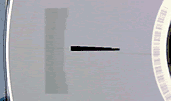
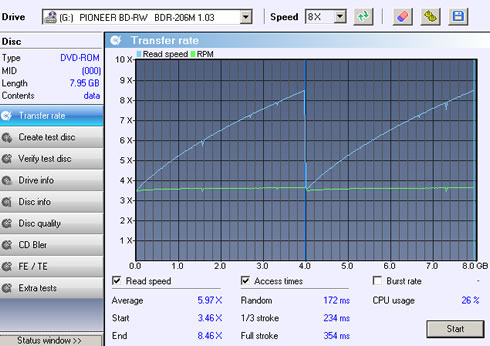
Reading was successful without any errors. In some areas the transfer rate graph was not so smooth, meaning that the drive had to momentarily slow down to cope with the problematic areas of the disc.
ABEX TDV-545
The TDV-545 disc is based on the TDV-540 series. It is a single sided, dual layer DVD-VIDEO disc with a capacity of 8.5GB.The TDV-545 includes artificial black dots on the data surface, sized from 0.4 to 1.0 mm. It also has 65 - 75 micrometer fingerprints.

The drive easily read the disc with some minor issues in the end of L0, where is slowed down a bit to resume reading afterwards.
Summary
Overall, the Pioneer BDR-206MBK drive seems to be capable of reading defected DVDs, at least as long as the size of the defects on the disc surface remain within the strict limits of our test discs.
5. CD/DVD Testing platform - The IQB Omni CD DVD Analyzer by Quantized

All CD/DVD writing quality tests are done using the IQB Omni CD DVD Analyzer by Quantized. The IQB Omni from Quantized Systems is a physical disc analyzer,
covering all CD and DVD formats,
designed to meet the Quality Control
demands of the duplication and
replication sectors.
Omni's features allows you to identify media quality issues and highlight drive performance and recording problems.
The system is based on a Philips CD/DVD drive. It supports the majority of the optical disc formats, including CD-ROM, CD-R/RW, CD-A
DVD-R/-RW, DVD-R DL, DVD+R/+RW, DVD+R DL, DVD-ROM 5 and DVD-ROM.

The platform can test the media for the following signals:
| CD-R/CD-ROM/CD-A |
DVD+R/+RW |
DVD-R/-RW |
DVD-ROM |
| Reflectivity |
R-I14H |
R-I14H |
R-I14H |
| Jitter |
Modulation |
Modulation |
Modulation |
| I11/ITop |
Jitter |
Jitter |
Jitter |
| Asymmetry/Beta |
PI Sum 8 |
PI Sum 8 |
PI SUm 8 |
| BLER |
PI Unc |
PI Unc |
PI Unc |
| E11 to E32 Error Statistics |
POF |
POF |
POF |
| Burst Errors |
Beta |
Beta |
Asymmetry |
| |
ADER |
|
EDC |
| |
ADER Unc |
|
|
Test speeds for CD media are set at 16X and for DVD media at 4X.
The equipment is capable of providing measurements on the complete data area or at specific positions defined by the user (Quick Test mode). This zone testing procedure allows multiple areas of the
disc to be tested in a single operation.
All numerical and graphical data are stored in a database. Data can be recalled with user defined criteria to create sets of related key results. Data can also be imported into most common software
packages - MS Excel etc.
For more information on the Quantized IQB Omni Analyzer, visit http://www.quantized.com.
In the following pages, we present the writing quality measurements of various CD and DVD recordable and rewritable media, burned with the Pioneer BDR-206MBK v1.03 burner.
6. CD-R burning - Mitsubishi CD-R 52x 74min Supper-Azo 74
For this test (and for all ensuing tests with CD-R media), the CD-R disc was burned to its maximum capacity and at its maximum speed. Then, the same disc is read with the OptiDrive Control v1.51software, and the disc was scanned for digital error parameters (E31, E32, bler), jitter, reflectivity as well as HF signals related to the quality of the signal.
- Disc Info (Mitsubishi CD-R 52x 74min Supper-Azo 74)

- Writing - 24x Z-CLV (20.80x average) in 04:04 min

- Reading - 24x CAV

- Quality - iQB OMNI





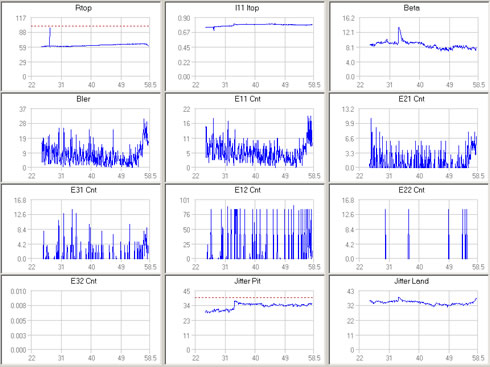
A good result for the Pioneer drive with the Verbatim CD-R. The reported digital errors were within acceptable limits (correctable) and jitter was also normal for a CD-R.
7. CD-R burning - TDK [Ritek] CD-R 80min 52x
- Disc Info (TDK [Ritek] CD-R 80min 52x, Dye Type7 [PhthaloCyanine])

- Writing - 24x Z-CLV (20.95x average) in 04:18 min

- Reading - 24x CAV

- Quality - iQB OMNI



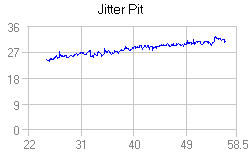


Another good burn for the Pioneer drive.
8. CD-RW burning - Verbatim CD-RW Ultra Speed+ 32x
- Disc Info (Verbatim CD-RW Ultra Speed+ 32x)

- Writing - 24x Z-CLV (21.65x average) in 4:07 min

- Reading - 24x CAV

- Quality

The specific disc was measured using the Opti Drive Control software since our Quantized system does not support measurements with CD-RW discs. The result is good and no C2 errors were reported.
9. DVD-R burning - Ricoh DVD-R SL 16x
We start our DVD writing quality measurements with DVD-R media. A variety of different MIDs were selected and burned at the maximum allowed speed. In each of the following pages, you will find detailed information about each disc, the burning and reading procedure as well as the related signal measurements that construct the overall quality picture for each disc.
You can always navigate across to the different MIDs in this review, using the page navigation drop down menu.
- Media Info (Ricoh DVD-R SL 16x)

- Writing - 8x Z-CLV (7.51x average) in 08:09 min

- Reading - 8x CAV

- Quality - iQB OMNI


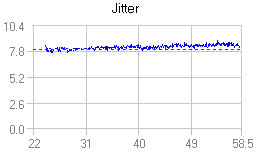
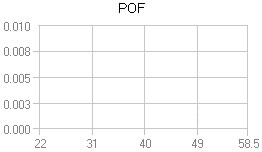

Another good burn with the CMCMAG AM3 disc at 8x. Reflectivity (RI14) was a little low in the beginning of the disc but no read-out difficulties were observed, and the digital errors were well within the acceptable limits.
10. DVD-R burning - TDK DVD-R SL 16x
- Media Info (TDK DVD-R SL 16x)

- Writing - 8x Z-CLV (7.52x average) in 8:08 min

- Reading - 8x CAV

- Writing Quality - iQB OMNI





The burn was great again although reflectivity was a little lower than the limit until the 40mm radius of the disc. On the other hand, the HF signal is strong enough revealing good-shaped pits on the recording layer.
11. DVD-R burning - CMC Magnetics DVD-R SL 16x
- Media Info (CMC Magnetics DVD-R SL 16x)

- Writing - 8x Z-CLV (7.51x average) in 08:10 min

- Reading 8x CAV

- Quality - iQB OMNI





Another good burn here without uncorrectable errors or high jitter. The Beta graph has a dip at the 29.7mm radius of the disc, which is most probably at the position where the drive slowed down spinning to immediately jump to the 8x burning speed.
12. DVD-R burning - Ridisc DVD-R SL 16x
- Media Info (Ridisc DVD-R SL 16x)

- Writing - 8x Z-CLV (7.51x average) in 08:09 min

- Reading - 8x CAV

- Quality - iQB OMNI





The PI8 graph is rising towards the outer area of the disc but it remained well below the 280 limit. No POF was reported.
13. DVD-R burning - Taiyo Yuden DVD-R SL 16x
- Media Info (Taiyo Yuden DVD-R SL 16x)

- Writing - 8x Z-CLV (7.50x average) in 08:09 min

- Reading - 8x CAV

- Quality - iQB OMNI





No problems were reported here.
14. DVD+R burning - Philips DVD+R SL 16x
- Media Info (Philips DVD+R SL 16x)

- Writing - 8x Z-CLV (7.50x average) in 08:11 min

- Reading - 8x CAV

- Quality - iQB OMNI





The quality of the specific burn should be consider as good. The reflectivity (RI14) is slightly low(in the beginning of the disc while jitter is marginally higher than expected in the end of the disc. None of these should be considered as important provided that the limits for the signals are very strict.
You may also notice the spike at the ADER (Address in Pre-pit Error Rate) and ADER Unc graphs. The parameter is considered as for the DVD "+" formats only. These are part of the so-called "closed loop" signals, which are deduced when the optical head follows the track in the same way as during normal data reading. Tracking signals are switched on and the feedback coming from them allows the head to follow the groove.
There is no specification for the ADER parameters. However, practice shows that when all other features of the wobble such wobble amplitude, wobble beat or wobble CNR are within their specifications, the information encoded in the one can always be read correctly. Unfortunately our equipment does not measure these wobble-related features. Provided that the signals related to data errors (PISum8, POF, PIF) are well within the limits, we could just say that these peaks on the ADER graphs should be attributed to the Z-CLV writing strategy of the Pioneer drive: Wobble signal is used to control the rotational speed of the disc to maintain constant Linear Velocity (CLV). For DVD+R it also contains disc information and addressing data encoded through the wobble phase modulation. Provided that the ADER peaks at the graphs appear at the position where the drive increased its burning speed from 6x to 8x (6-8x Z-CLV), this sharp rise of the recording speed should be related to them.
Moreover, a strong error correction code (ECC) implemented in the wobble encoded data helps to recover any missing signals.
15. DVD+R burning - Moser Baer India DVD+R SL 16x
- Media Info (Moser Baer India DVD+R SL 16x)

- Writing - 8x Z-CLV (7.52x average) in 08:09 min

- Reading - 8x CAV

- Quality - iQB OMNI





Another great burn with the Moser Baer India DVD+R SL disc at 8x.
16. DVD+R burning - Verbatim DVD+R SL 16x
- Media Info (Verbatim DVD+R SL 16x)

- Writing - 8x Z-CLV (7.51x average) in 08:10 min

- Reading - 8x CAV

- Quality - iQB OMNI





Again, there is not much to say here. The disc easily passed the quality check test.
17. DVD+R burning - Datawrite Titanium DVD+R SL 16x
- Media Info (Datawrite Titanium DVD+R SL 16x)

- Writing - 8x Z-CLV (7.52x average) in 08:10 min

- Reading - 8x CAV

- Quality - iQB OMNI





All the important parameters here are well beyond the acceptable limits. Again, the ADER and ADER UNC graphs have a peak in the position where the drive jumped from 6x to 8x writing speed. This should not be an issue as we described in the previous pages and it commonly occurs with DVD+R discs using Z-CLV writing strategy.
18. DVD+R burning - Taiyo Yuden DVD+R SL 16x
- Media Info (Taiyo Yuden DVD+R SL 16x)

- Writing - 8x Z-CLV (7.50x average) in 08:11 min

- Reading - 8x CAV

- Quality - iQB OMNI





The results with the popular Taiyo Yuden DVD+R disc is good since PISum8 is low and POF is zero. Both the reflectivity (RI14) and the modulation are a little bit low for all the disc area. Modulation is directly related to the recording marks on the disc but hopefully, the disc was perfectly readable with low PISum8 errors.
19. DVD+R DL burning - Verbatim DVD+R DL 8x
- Media Info (Verbatim DVD+R DL 8x)

- Writing - 8x Z-CLV (6.98x average) in 15:52 min

- Reading - 8x CAV

- Quality - iQB OMNI





A good quality with the specific DVD+R DL disc without POF and with low PISum8. The reflectivity is low and that's generally occurring with DVD R DL media. On the other hand, the modulation is adequate. Jitter was also slightly increased for both layers.
ADER was also increased as the disc's rotational speed was briefly fluctuating towards the end of L0 and the beginning of L1.
20. DVD-R DL burning - Verbatim DVD-R DL 8x
- Media Info (Verbatim DVD-R DL 8x)

- Writing - 8x Z-CLV (6.60x average) in 17:12 min

As you see in the above graph the drive was trying to recover from the writing speed dips in the beginning of L1 and reached the 8x speed after the 5GB mark of the disc.
- Reading - 8x CAV

Despite the fluctuations of the burning speed in the beginning of L1, the reading graph was smooth.
- Quality - iQB OMNI





The PI8 is generally low, the POF is zero and jitter was higher than expected for both layers. The reflectivity is also lower than we expected for both layers, although modulation looks good. Asymmetry (BETA) is also lower than the limit (-0.05) in the beginning of both layers. This should be attributed to the writing strategy of the drive, especially for the beginning of L1, where the drive could not write at 8x for some time.
21. DVD-RW burning - TDK DVD-RW 6x
- Media Info (TDK DVD-RW 6x)

- Writing - 6x CLV (5.97x average) in 10:21min

- Reading - 8x CAV

- Quality - iQB OMNI

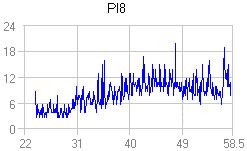



That's a good burn with the TDK DVD-RW disc at 6x. .
22. DVD+RW burning - Verbatim DVD+RW 8x
- Media Info (Verbatim DVD+RW 8x)

- Writing - 8x X-CLV (7.50x average) in 8:27 min

- Reading - 8x CAV

- Quality - iQB OMNI





The drive seems to be optimized to burn the specific DVD+RW correctly. Only jitter is slightly above the limits.
23. DVD-RAM burning - Maxell DVD-RAM 5x
- Media Info (Maxell DVD-RAM 5x, MXL16)

- Writing - 5x CLV (4.96x average) in 11:29min

- Reading 5X CLV

The Pioneer BDR-206MBK DVD burner had not any reading/writing problems with both the Maxell DVD-RAM discs of this test.
DVD-RAM is a rewritable format supported by the DVD Forum. A DVD-RAM can be seen as a removable hard drive. However, as any other hard drive the DVD-RAM must be "prepared" (formatted) before the first use. A DVD-RAM disc must be formatted using the UDF (Universal Disk Format). Usually, a 4.7GB DVD-RAM should be formatted using the UDF 1.5 or the UDF 2.0 format.
Notice that in the above tests we showcase the maximum recording speeds supported by the drive with the specific DVD-RAM media. In case you are using your DVD-RAM discs as a removable hard drive through your Windows OS, you may experience slower burning. That because the DVD-RAM format features an automatic verification technology that results to safer but slower recordings.
24. BD XL burning - TDK BD-R TL (Triple Layer) TDKBLDRNC BDXL
Let's start with the BDXL recording tests. Here we used a BD-R TL (Triple Layer) disc. It is based on the Blu-ray Disc Association's (BDA) BDXL (High Capacity Recordable and Rewritable discs) specifications, which was introduced last year.
The BDXL specification was initially targeted primarily at commercial segments such as broadcasting, medical and document imaging enterprises with significant archiving needs. However, many consumer Blu-ray disc players have been supporting the format, especially those appearing at the Japanese market. The BDXL discs will be available in write-once versions with capacities of 100GB (BD-R TL) and 128GB (BD-R QL) and also in 100GB rewritable versions (BD-RE TL). The discs reach these capacities by incorporating three to four recordable layers.
Currently, TDK / Imation is the sole company that manufactures BD XL recordable discs. The discs feature three recordable layers and are able to hold up to 100GB of data (95.6 GB to be exact). TDK's BD-R TL (Triple Layer) discs are recognized as TDKBLDRNC ( MID.) Here is some information on these discs, as it is reported by Erik Deppe's OptiDrive Control utility:

Currently, Sony, Sharp and Panasonic are also using TDK's discs in an OEM basis and offer them under their brands. Mitsubishi Kangaku Media (MKM), the company better known for its Verbatim brand, will also release its own BD-R TL (100GB) discs sometime in the autumn of this year.
We should notice here that the TDK BD-R TL discs are really expensive and are currently retailing for 4,300 - 5,000 YEN ($52~$60 / €39~€45)
, mainly due to limited supply.
BD-RE TL discs are not available in market yet.
The BDXL discs require hardware (players/recorder) that is compatible with the BDXL format and carry the corresponding logo. So previous generation BD players or recorders/burners cannot recognize the discs.
The BDXL format is specified in six format books for both recordable and rewritable discs:
R3 Format Specification (BDXL)
This version was defined in June 2010 and is a multi-layered recordable in BDAV with the speed of 2X and 4X, capable of 100/128GB and usage of UDF2.5/2.6 as file system:
- System Description Blu-ray Disc Recordable Part 1: Basic Format Specifications Ver. 2.0 June, 2010
- System Description Blu-ray Disc Recordable Part 2: File System Specifications Ver. 2.0 June, 2010
- System Description Blu-ray Disc Rewritable Part 3: Audio Visual Basic Specifications Ver.4.01 Sept. 2010 together with System Description Blu-ray Disc Rewritable Format Part 3: Audio Visual Basic Specifications Ver.2.13 Sept. 2010
RE4 Format Specification (BDXL)
This version was defined in June 2010 and is a multi-layered rewritable in BDAV with the speed of 2X and 4X, capable of 100GB and usage of UDF2.5 as file system.
- System Description Blu-ray Disc Rewritable Part 1: Basic Format Specifications Ver.3.0 June, 2010
- System Description Blu-ray Disc Rewritable Part 2: File System Specifications Ver.3.0 June, 2010
- System Description Blu-ray Disc Rewritable Part 3: Audio Visual Basic Specifications Ver.4.01 Sept. 2010 together with System Description Blu-ray Disc Rewritable Format Part 3: Audio Visual Basic Specifications Ver.2.13 Sept. 2010
Compared to the BD-R DL, the BD-R TL disc features three layers of data (L0, L1 and L2), with a thickness of 100um(L0),75um(L1) and 57um(L2). The thickness of the L0 and the L1 are the same for both BD-R DL, the BD-R TL. However, each layer of the BD-R TL disc holds 33.4GB of data, which is 8.4GB more than what the layers of BD-R SL and DL can hold (25GB). In order to achieve this, the BD-R TL features an increased linear density. It uses shorter marks on the recording layer (112nm for BD-R TL) and also applies the Integrated-Maximum-Likelihood-Sequence-Error-Estimation technology or i-MLSE using PR(1,2,2,2,1) signal quality evaluation index. Other than that, the BDXL discs use the same addressing and modulation method also met with legacy BD-R SL and DL media.
So the main difference with legacy BD-R format are cover layer thickness distribution,
capacity per layer, minimum mark length and evaluation index for signal quality. For both TL and QL, the BDA has specified 2X
and 4X recording of 72~144Mbps user transfer rate.
The following table shows the main parameters of BD-R, including for both TL of 100GB capacity and QL of
128GB capacity format:

In BDXL, the Inter-Symbol-Interference (ISI) of the
readout signal becomes much stronger compared to the prior format that allows just 25GB per layer.
Therefore the readout signal processing needs to be improved. Also, the prior signal quality evaluation
method using the Limit-Equalizer technology has turned out to be no longer applicable.
The Integrated-Maximum-Likelihood –Sequence-Error-Estimation (i-MLSE), which is an alternative signal quality
evaluation method for BDXL, was newly developed by Sony and Panasonic and was first presented two years ago. The i-MLSE retains the stability and the precision in such a
severe ISI condition of BDXL. The evaluation method of i-MLSE stands on the detection principle of the
Viterbi-Algorithm (VA) in the Partial-Response-Maximum-Likelihood (PRML) readout signal processing.
Additionally, some contrivances can be incorporated to achieve the better correlation with the
Symbol-Error-Rate (SER). For example, the tendency of error occurrences with the PR(1,2,2,2,1) ML readout
in the BDXL is considered. Another feature of i-MLSE is that the mathematical expression is the same as
that of Time-Interval-Jitter (TI-Jitter or Jitter, simply), which is the prior signal quality evaluation method.
Consequently, the behavior of i-MLSE is very similar to that of the TI-Jitter. This helps people who evaluate
the BDXL discs or systems for the first time to comprehend the meaning of measured values obtained
through i-MLSE because the TI-Jitter has been used so long since the era of CDs and is very familiar to
them.
Burning a TDK BD-R TL disc
For our burning tests, we used the Pioneer BDR-206MBK v1.3 burner and a TDK BD-R TL disc (TDKBLDRNC (000)). The drive supports 4X CLV (144Mbps) burning and reading for the specific disc. We remind you that the drive is also capable of burning BD-R QL (quad-layer, 128GB) discs at 4x, as well as BD-RE TL discs at 4X. However, such discs are not yet available anywhere in the world.
For the test we created a Blu-ray UDF compilation using Nero's Burning Rom software Ver. 10.2. Most of you should be familiar with the specific software and burning a BD-R TL disc does not make any difference. Here is how the software identified the TDK disc we had inserted into the drive's tray:

As you see, the blank BD-R TL disc offers a capacity of 95.466 MB.
Let's move on the settings before burning data on the disc. Our compilation included multiple data files (95.409 MB).



We chose to burn a non-multisession disc (disc-at-once):

The UDF settings were left to default. The software has selected the UDF 2.5 file system for this burn:

The final step before burning was to set the typical settings related to the recording procedure; finalization of the disc data verification - which we selected in order to check whether our data was burned correctly on the disc - and finally the writing speed. You can chose the 2x or 4x CLV burning speed:

With a simple calculation, our 95.409 MB data compilation will be burned at 4X CLV in approximately 1hr and 30 minutes. We start the burning procedure:
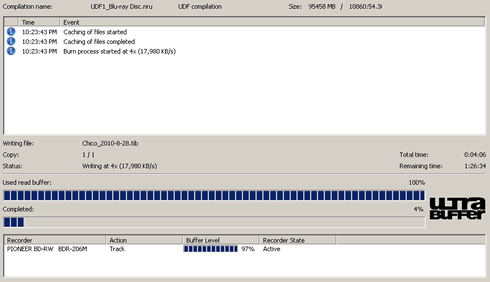
After 1hr 43 minutes and 23 seconds, our disc was ready:

Verifying the recorded data is always important, especially when it comes to burning multiple files on a disc. In our case, Nero's verification process was as slow as writing, since the disc was read at 4X CLV. The verification was successful:
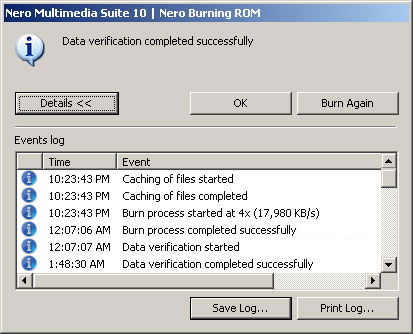
The files on the TDK BD-R TL disc were easily accessible the readable through Windows Explorer.
For your information, the currently available disc testing utilities such as the OptiDrive Control v1.51 or Nero's CD Speed and Disc Speed do not fully support the BD-R TL discs. These tools are very convenient since they are displaying the writing / reading strategy of a burner and they are also offering other tests such as seek / access time for each disc or layer switch time for multi-layered discs. Although the utilities read the disc, they cannot deal with its increased capacity and treated them like BD-R DL media. Of course, we expect the OptiDrive Control software to support the the BD XL discs in a future version. For your reference only and although this test is not accurate (seek times, disc length) , here is a transfer rate (read) test of a TDK BD-R XL disc:

As you can see the software recognized the length of the disc (90:23GB) but it just read some part of it, finishing the reading task relatively quickly. We just show you the graph in order to see the 4X CLV reading strategy of the Pioneer BDR-206 MBK drive.
25. BD-R burning - Verbatim BD-R SL LTH for 6x (VERBATIMu)
In our recording tests with BD-R/RE SL /DL discs, each disc was burned at the highest allowed recording speed. The Pioneer BDR-206MBK drive supports 6x burning for BD-R SL and BD-R DL media. The discs we used for this test were kindly provided by Mitsubishi Kangaku Media (MKM), the manufacturer of the popular Verbatim branded discs, Moser Baer India, Panasonic and Imation/TDK.
We also used Erik Deppe' s Opti Drive Control software for testing the writing quality of each recorded BD-R/RE SL and DL discs. The software could give you an idea of the writing quality of each disc. For BDs, the following parameters are measured:
- LDC (Long Distance Code): number of parity errors on LDC codewords per ECC block (32 sectors)
- BIS (Burst Indication Subcode): number of parity errors on BIS codewords per ECC block (32 sectors)
On a good disc, the average LDC should stay below 13 and BIS should stay below 15, according to the author of the software.
If you are interested in the data recovery methods of the Blu-ray discs, continue reading below.
Blu-ray Data Recovery Methods: Partial Response - Maximum
Likelihood (PRML)
For CD and DVD, the method for data detection was
based on a zero crossing point method, using a
conventional slicer. Basically, when the analogue
signal (output from the optical pick-up) crosses a
reference level, it indicates a binary transition.
This method has its limitations, notably when the
feature size (smallest pit/land) is less than the
spot size, the modulation of the light is relatively
small (the smaller the pit/spot size ratio the smaller
the modulation). Thus, the conventional slicer can
create data with non-exact mark/space lengths -
otherwise known as jitter, and when this jitter
becomes greater than 0.5 of a clock cycle, it becomes
a bit error.
For BD, the minimum spot radius ratios are 0.88 and
0.85 of the ratio of DVD. This reduced resolution
(low modulation of light by 2T pits) means that it
is much more difficult to have effective data
detection using a conventional slicer. Boosting the
high frequency part of the signal has limited effect
because this also increases the Inter Symbol
Interference (ISI), which is where adjacent pits and
lands interfere with each other. This is mainly a
problem with the shortest run lengths, particularly
those that are smaller than the spot size.
Hence for BD, the Partial Response- Maximum
likelihood (PRML) method is used for recovering the
data from the signal.
Partial Response (PR) equalization is used to limit
the effects of ISI, and then a sequence of bits is
evaluated to define the most likely sequence of
bits, based upon known allowed sequences. This is
the Maximum Likelihood (ML) detection and uses a
Viterbi algorithm to determine the ML sequence.
The Blu-Ray disc is more sensitive to burst errors
compared to the DVD system. Therefore, the error
correction system of Blu-Ray disc should be able to
cope well with long burst errors, rather with single
(random) errors.
The maximum number of errors that can be corrected depends on the number of parity symbols added. For each two parity symbols added, one error can be corrected. But Blu-Ray uses a more efficient approach to correct the burst errors. It uses a burst indicator mechanism that can detect bursts of errors before the correction starts. The advantage of this method is actually the prior knowledge of the error locations on the decoding process.
These burst indicator used in the Blu-Ray format is called picket code. The pickets are columns that are inserted in between columns of the main data at regular intervals. The main data is protected by a Reed Solomon code, while the pickets are protected by a second independent Reed Solomon code. When decoding (reading), first the picket columns are corrected. The correction information can be used to estimate the location of possible burst errors in the main data.

A Blu-ray Disc Error Correction Block (ECC Block) can store 64 Kilobytes of user data. This data is protected by the Long Distance Code (LDC) which has 304 code words with 216 information symbols and 32 parity symbols giving a code word of length 248. These code words are interleaved two by two in the vertical direction such that a block if 152 bytes x 469 bytes is formed as shown in the picture above.
A Blu-Ray Disc ECC block contains 4 equally spaced picket columns. The left most picket is formed by the sync pattern at the start of each row. If the sync pattern was not detected properly, that can be an indication for a burst error similar to the knowledge that a symbol of a picket column had to be corrected. The other three pickets are protected by the so-called Burst Indicator Subcode (BIS). The BIS code words are interleaved into three columns of 496 bytes each. Both LDC and BIS codes are decoded by the Reed Solomon decoder.
Reference: BD-ROM Physical Specifications
- Media Info
For the first test we used the Verbatim BD-R 25GB LTH disc for 6x burning. The specific discs have been manufactured using the "Low-To-High" (LTH) process. The LTH write-once BD-R media feature an organic dye recording layer, making them different that the currently available BD-R discs that use inorganic materials.
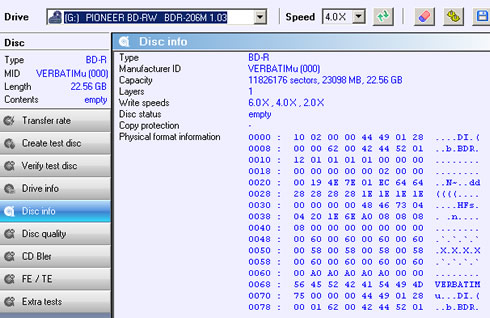
- Writing - 6x Z-CLV (5.63x average) in 16:15 min

- Quality

Both LDC and BIS values (average) stay within the acceptable limits.
26. BD-R burning - Moser Baer BD-R SL for 6x (MBI R06)
- Media Info
Moser Baer India is also among the manufacturers of recordable Blu-ray discs that are currently offering BD-R SL discs certified for 6x recording.
Here we used the Moser Baer BD-R SL for 6x (MBI R06) discs. The Pioneer BDR-206MBK drive will burn the disc at 6x:

- Writing - 6x Z-CLV (5.63x average) in 16:14 min

- Quality

It seems that the quality of the disc is good, with the reported average LDC and BIS to be low.
27. BD-R burning - Verbatim BD-R SL for 6x (VERBATIMe)
- Media Info
This is Verbatim BD-R 25GB disc (VERBATIMe (000)) certified for 6x recording.
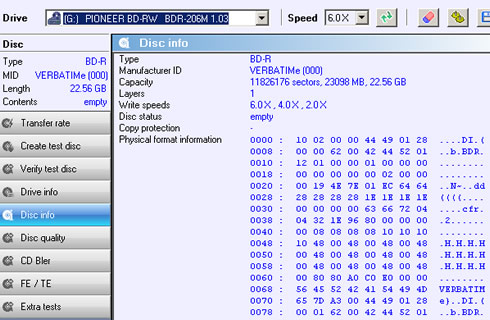
- Writing - 6x Z-CLV (5.63x average) in 16:14min

- Quality

28. BD-R burning - Sony BD-R SL for 6x (SONYNN3)
- Media Info
This is a Sony BD-R SL (SONYNN3), certified for 6x recording.

- Writing - 6x (5.63x average) in 16:15 min

- Quality

Without any doubt there is a problem here. LDC,BIS and jitter are amazingly high after the 21GB mark. These influenced the readability of the disc as you see in the above graph (blue line). Reading was complete but definitely the drive had hard times reading the specific problematic area.
29. BD-R burning - TDK BD-R SL for 6x (TDKBLDRBD)
- Media Info
We proceed with another disc from TDK. This BD-R SL disc (TDKBLDRBD) offers a nominal capacity of 25GB and it is certified for 6x recording.

- Writing - 6x X-CLV (5.63x average) in 16:13min

- Quality

The disc was readable but LDC is higher than 13. Both jitter and LDC was increased after the 22GB mark.
30. BD-R burning - TDK BD-R DL for 4x (TDKBLDRFB)
- Media Info
This is TDK BD-R DL 50GB disc (TDKBLDRFB (000)) certified for 4x recording.

- Writing - 4x (3.95x average) in 46:09 min
For this test we used the CD-DVD Speed utility since the Opti Drive Control software could not recognize the disc:

- Quality

The disc was not readable and the software reported high LCD and jitter in the beginning of L1. The result was a read error at around the 21GB mark.
31. BD-R burning - Sony BD-R DL for 4x (MEIT02)
- Media Info
The specific Sony BD-R DL disc (MEIT02) offers a capacity of 50GB and it is certified for up to 4x recording.

- Writing - 4x (3.95x average) in 46:06min
Here we used the used the CD - DVD Speed utility instead of the Opti Drive Control since the latter utility could not recognize capacity of the specific disc:

- Quality

The average reported LDC was higher than the acceptable limit of 13, although the disc was readable.
32. BD-R burning - Verbatim BD-R DL for 6x (VERBATIMf)
- Media Info
This is a Verbatim 8cm BD-RE disc for 2x. The available capacity is 7.5GB.

- Writing - 2x (1.99x average) in 9:13 min

- Quality

The average LDC is higher than expected here although the disc was readable.
33. BD-RE burning - Philips BD-RE SL for 2x (PHILIPW02)
- Media Info
This is a Philips BD-RE SL disc (PHILIPW02) for 2x recording.

- Writing - 2x (1.98x average) in 45:37min

- Quality

It is obvious that the drive's writing strategy with the specific disc is not the appropriate one. After both LDC and BIS skyrocketed at around the 15.5GB mark, the drive slowed down reading to 4x in order to read the complete disc.
34. BD-RE burning - Sony BD-RE DL for 2x (MEIT01)
- Media Info
This is a Sony BD-RE DL 50GB disc (MEIT01) for 2x recording.

- Writing - 2x (1.98x average) in 90:53 min

- Quality

Both the LDC and BIS (average) values are acceptable here indicating a good burn.
35. BD-RE burning - TDK BD-RE DL for 2x (TDKBLDWfa)
- Media Info
This is another TDK BD-RE DL disc (TDKBLDWfa (000)) for 2x recording.

- Writing - 2x (1.98x average) in 90:56min

- Quality

The reported average LDC is much higher than 13 and as such, this should be considered as a problematic burn.
36. BD-RE burning - Verbatim 8cm BD-RE for 2x (VERBATIM0)
- Media Info
This is a Verbatim 8cm BD-RE disc for 2x. The available capacity is 7.5GB.

- Writing - 2x (1.99x average) in 9:13 min

- Quality

The average LDC is higher than expected here although the disc was readable.
37. Summary of CD/DVD/BD writing quality tests, Bit setting, Overburning
In the following table we have gathered the findings of the DVD and CD quality measurement tests. On the left side of the table, you can find the discs that did not produce uncorrectable digital errors (POF) and the correctable ones (PI8) were less than 280. On the right side they are the discs that failed in the tests:
| Media type |
Digital errors within limits |
Uncorrectable errors (POF) |
| DVD-R
|
Ricoh (CMCMAG AM3) burned at 8X |
|
| TDK (MBI01RG40) burned at 8x |
| Ridisc (TTH02 F02) burned at 8x |
| CMCMAG AE1 burned at 8x |
| Taiyo Yuden (TYG03) burned at 8x) |
| DVD+R |
Verbatim (MCC 004) burned at 8x. |
|
| Taiyo Yuden (YUDEN000 T03) burned at 8x |
|
Philips (INFOME R30) burned at 8x |
|
| MBI PG101R05 burned at 8x |
|
| Datawrite Titanium (PRODISC R04) burned at 8x |
|
| DVD+RW |
Verbatim (MKM A03) burned at 8x |
|
| DVD-R DL |
Verbatim (MKM 003) burned at 8x |
|
| DVD+R DL |
Verbatim (MKM03RD30) burned at 8x |
|
| DVD-RW |
TDK (CMCW04) burned at 6x |
|
| CD-R |
TDK CD-R 80min 52x, Cyanine 80 burned at 24x |
|
|
Mitsubishi CD-R 52x 74min Supper-Azo 74 burned at 24x |
|
| CD-RW |
Verbatim CD-RW Ultra Speed+ 32x burned at 24x |
|
- BD Media quality
In the following table we have gathered the writing quality results we got with the BD-R/RE media of this test using the Opti Drive Control software. We remind you that for BDs, the following parameters are measured:
- LDC (Long Distance Code): number of parity errors on LDC codewords per ECC block (32 sectors)
- BIS (Burst Indication Subcode): number of parity errors on BIS codewords per ECC block (32 sectors)
On a good disc, the average LDC should stay below 13 and BIS should stay below 15, according to the author of the software.
Media type |
MID |
average LDC (<13) |
average BIS (<15) |
BD-R SL
|
Verbatim BD-R SL LTH 6x VERBATIMu burned at 6x |
7.19 |
0.11 |
Verbatim BD-R SL 6x VERBATIMe burned at 6x |
5.24
|
0.07 |
Moser Baer India BD-R SL 6x MBI R06 burned at 6x |
5.58 |
0.10 |
Sony BD-R SL 6x SONYNN3 002 burned at 6x |
106.39 |
4.62 |
TDK BD-R SL 6x TDKBLDRBD burned at 6x |
16.93 |
0.26 |
BD-R DL |
VERBATIM BD-R DL 6x (VERBATIMf) burned at 6x |
11.69 |
0.18 |
Sony BD-R DL 4x (MEIT02) burned at 4x |
16.88 |
0.25 |
TDK BD-R DL 4x (TDKBLDRFB (000)) burned at 4x |
Read error |
BD-RE SL |
Verbatim 8cm BD-RE SL 2x VERBATIM0 7.26GB) burned at 2x |
51.15 |
1.03 |
Philips BD-RE SL 2x PHILIPW02 burned at 2x |
2769.46 |
218.48 |
BD-RE DL |
Sony BD-RE DL 2x MEIT01 burned at 2x |
10.98 |
0.23 |
TDK BD-RE DL 2x TDKBLDWFa burned at 2x |
52.60 |
1.07 |
- Bit Setting


- Overburning



38. Final thoughts

Although the growth of Blu-ray in desktop is not as fast as we originally expected some years ago, the technology continues to develop. Pioneer made the step further to introduce the first BD XL Blu-ray disc burner, the BDR-206MBK. Without any doubt, the drive marks a new phase in the Blu-ray technology and actually advances it to a level by boosting the amount of storage per disc up to 128GB.
The drive supports triple-layer BD-R (write-once) and BD-RE (rewritable) discs with huge capacities of 100GB, and even 128GB quad-layer BD-R discs. Given the layers involved, the BD XL (recordable) specifications are limiting the burning of these new BDXL discs to 4x speed. In our tests, the BDR-206MBK burned more than 95GB of data in 1 hr and 43 minutes, using the 4x CLV writing strategy. The TDK BD-R TL disc was fully readable. Of course, compared with the 11-12 minutes needed to write around 22GB at 12x to 6x -speed discs, this isn't a short process. And the upcoming rewritable BDXL media will run at just 2x CLV, which means that times get even slower.
The price of the BD XL media is also high - at least for now - since TDK's disc manufacturing capacity is limited. The TDK BD-R TL discs are really expensive and are currently retailing for 4,300 - 5,000 YEN ($52~$60 / €39~€45). Sony, Sharp and Panasonic are also using TDK's discs in an OEM basis and offer them under their brands. Mitsubishi Kangaku Media (MKM), the company better known for its Verbatim brand, will also release its own BD-R TL (100GB) discs sometime in the autumn of this year.
The Pioneer drive also supports burning of BD-R/RE SL and DL media. Speeds are limited to 6x for BD-R SL /DL and 2x for BD-RE SL /DL. These speeds are lower than those offered by other BD burners currently available at the market but Pioneer is expected to increase them with the successor of the BDR-206 drive - so it might be worth hanging on for that. The burning times we experienced are typical for these speeds (6x CAV or 2x CLV). The discs we used were generally readable with some exceptions; the TDK BD-R DL 4x (TDKBLDRFB (000)) burned at 4x which was unreadable and the Philips BD-RE SL 2x PHILIPW02 burned at 2x, which gave increased digital errors.
The writing quality
of the drive with BD-R and BD-RE was mediocre, with the results to vary according to the disc type we used for these tests.
Reading of BD discs was smooth and transfer rates also met the drive's advertised speeds. We should also mention Pioneer's successful efforts to make this drive as quiet as possible as the drive reads and writes BDs without any annoying noises or clicks coming out of it. The drive also produced smooth BD playback during testing.
The BDR-206MBK also supports the full range of legacy formats, from CD to DVD+/-R DL, although it isn't the fastest drive with older media. Specifically, the drive uses the 8x speed for writing DVD discs and 24x for burning CDs.
In the burning part, the Pioneer BDR-206MBk is is a great burner and the writing quality results with CD-R/RW , DVD +R/-R SL and DL media we tested were truly amazing.
Although the drive reads defected DVDs with out any problems, reading of defected CDs is definitely not among its strong points, at least according to our tests.
Without any doubt, the Pioneer BDR-206MBK packs excellent technology. However, available for a suggested retail price of $199, it's clearly not going to be a cheap drive. In addition, the current prices of BDXL 100GB and 128GB Blu-ray discs are exceptionally high. Admittedly, BDXL gives the security of a physical disc archive, but the low price of multi-terabyte hard disks or NAS devices are better options in terms of speed, convenience and flexibility, making the Pioneer drive a poor value. As a result, the BDR-206MBK faces an uphill struggle to achieve widespread adoption. On the other hand, professionals who need a reliable optical medium for archiving may find the drive appealing. Enthusiasts who are looking for a niche product may still find the Pioneer drive interesting, especially those who regularly back up huge amounts of data.